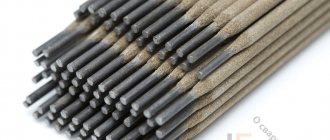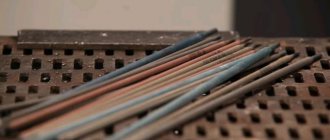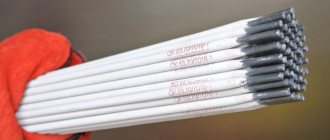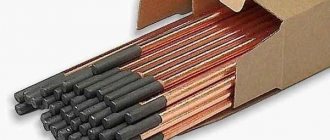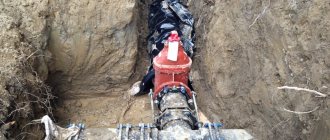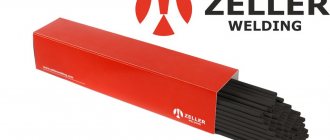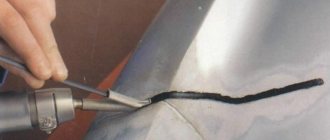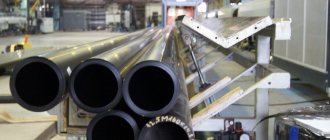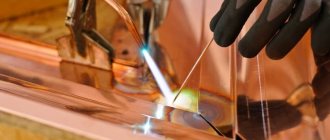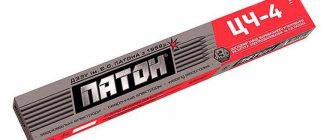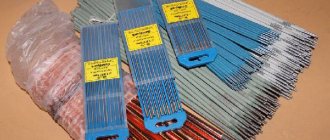Every welder, especially those who are just starting this difficult work, needs to know exactly what the electrodes are made of and what coating to choose correctly. The final result and quality of the seam will depend on this. In case of an error, then even professionals in this matter will not be able to correct the appearance of the completed joint of metal sheets. There are more than 200 different types of such consumables, so you need to be well versed in this. Electrode coating markings provide information about characteristics that every specialist in this field should know.
Features of electrode coating
The entire rod is covered with coating - a substance that is porous and hard in structure. Only the upper part, which is attached to the electric holder, is not covered; this is approximately 2-3 cm.
Role of coverage
What happens when part of the electrode burns out:
- Carbon monoxide and gas appear. The electrode coating provides protection for what is melted and prevents it from being oxidized by air.
- Ions are created that support combustion. These particles carry charge.
- Oxygen leaves the steel.
- The melt is alloyed, the properties are improved.
- The slag covers the fresh seam, which slows down cooling, prevents cracks, deformation and protects against air oxidation.
Positive changes apply differently to electrode coating types.
Type and polarity of current
Welding work can be performed using alternating or direct current. The first option is less desirable. It leads to increased spattering of molten metal, and the seam itself is less accurate and of less quality. When using direct current, direct and reverse polarity can be used.
Straight polarity
The part is connected to the positive pole, and the electrode holder is connected to the negative pole. In this case, it is the part that is exposed to more heat. For this reason, straight polarity is used when welding metals that have a high melting point or significant thickness.
Reverse polarity
When using reverse polarity, the part is connected to the negative pole and the electrode to the positive pole. In this case, the electrode heats up more, and the work as a whole is performed in a gentle mode. Reverse polarity is optimal for welding thin sheet parts or stainless steel.
Properties of coating components
Arc stabilization occurs using substances with low ionization characteristics:
- potassium chromate, potash, ammonium nitrate;
- binding silicate glue with potassium;
- calcium carbonate;
- titanium concentrate.
For deoxidation: aluminum; graphite; manganese; titanium; chromium; molybdenum.
Protective gases are created by: marble; starch; cellulose; dextrin; wood flour for food.
Alloying additives: molybdenum; titanium; silicon; graphite; manganese; chromium.
Elements that influence the formation of slag: chalk; marble; potassium; spar; titanium concentrate; manganese ore; quartz sand; ilmenite; rutile
Additives for plasticity: coalite; bentonite.
There are other additives that are used to obtain certain properties.
Electrode color
All types have their own colors:
- sour - gray;
- rutile - gray, brown, blue, green;
- basic - white or beige;
- cellulose - slightly gray with a hint of brown.
Most of the electrodes are divided into such groups and of the same color, but you can also find green main ones.
Electrode properties
The properties of electrodes mean their three components:
- Physical properties of the coating. These include coefficients of volumetric and linear expansion, gas permeability, density, viscosity, heat capacity, solidification and melting temperatures.
- Chemical properties of the coating. They mean the ability of the coating to alloy and deoxidize the molten metal.
- Mechanical properties of weld metal. These include hardness, toughness, elongation, ductility, corrosion resistance and hardness.
In the catalog or passport for each brand of electrodes, manufacturers indicate their most important characteristics.
Welding electrode coating
Shell production stages:
- Grind the components into fine powder.
- Sifting through and mixing in precise proportions.
- Introduction of a binding component - liquid glass.
- Knead until desired consistency.
Coating methods:
- dipping - coating of electrodes for manual arc welding by immersion for some time in coating;
- crimping - coating is applied to the rods using automatic presses.
The accuracy of the components and the observance of proportions when preparing the coating affect the result, so good equipment plays an important role in the work.
Spatial position
There are five main spatial positions of the electrodes in which welding work can be carried out:
- The lower horizontal one is considered the most convenient and productive. A special case of this is the boat position.
- The T-type is similar to the lower horizontal, but requires more welding skill. In this case, the formation of undercuts on the vertical surface and sagging on the horizontal surface is possible.
- The horizontal position of the electrode on a vertical surface is considered quite difficult. To use it in practice, a bevel is most often made on the upper edge of the elements being connected.
- Vertical seams can be welded in two ways: up or down. In the first case, better quality of seams is ensured, and in the second - higher speed.
- The ceiling spatial position is considered the most difficult. It is not suitable for connecting thin elements and is used only when it is impossible to carry out welding work in any other way.
Manufacturers must indicate in what spatial positions welding work can be carried out using electrodes.
Spatial positions of the electrode
Importance of slag
The slag formed during manual arc welding is divided into two types: “long” and “short”. In the first, the viscosity increases slowly with decreasing temperature. For this reason, electrodes with coatings that form “long” slags are not suitable for welding in vertical and overhead spatial positions. For “short” slags, the viscosity increases much faster, so they effectively prevent liquid metal from flowing out of the weld pool. This result is obtained by electrodes with basic or rutile coating.
Effect of moisture on materials
Electrode coatings have a porous structure that absorbs moisture and water very well. As a result, there is a loss of protective properties and characteristics, and the quality of the seam.
Electrode durability rules:
- Store consumables in hermetically sealed containers. If the package is open, place it in an airtight container to prevent moisture and water from entering.
- Before use, you can dry it in ovens designed for this purpose, adhering to the specified temperature and time.
- An electrode that has not been used for 3 hours must be dried.
- More than 4 dryings in ovens are not recommended; this will lead to the coating falling off.
- The rutile shell manifests itself at the slightest moisture; you must first dry the product at a temperature of up to 200C and only use it for work after a day.
Cellulose coated electrodes
The coating of cellulose electrodes consists half of organic components, most often cellulose. A weld deposited with cellulose electrodes contains a high percentage of hydrogen. When welding with cellulose-coated electrodes, a uniform back bead is formed.
Electrodes with all of the above coatings are intended for welding low-alloy and carbon steels. All of them are used in order to obtain welded joints that differ in some special characteristics that are required by the operating conditions of metal structures.
Share on social networks
Main types of electrode coatings
The characteristics of the electrodes are significantly affected by the composition of the coating.
Rutile
The main component is titanium dioxide with the presence of magnesium carbonate, chalk, and ferromanganese.
Advantages:
- complete safety at work for welders;
- no splashing;
- high performance;
- stable arc with re-ignition;
- beautiful neat seam;
- high resistance to cracks;
- reliable connection of workpieces with scale or rust when the thickness of the electrode coating is up to 25 microns;
- universal, suitable for any task and work;
- ease of scale removal.
Sour
Composition of consumables from slag-forming components - manganese oxide, iron with the addition of organic substances, starch, dextrin and oxycellulose for gas protection.
Advantages:
- making seams in any position in space;
- there is no need to remove scale or rust;
- possible long arc welding without the appearance of a porous seam;
- high performance;
- welding with alternating current, thanks to the stability of the arc and a low-voltage transformer.
Pulp
It contains only organic substances that are flammable. Among them are cellulose, grass and wood flour, ferroalloys, talc, and organic resins.
Advantages:
- systematic arc burning;
- due to gas flows, deep penetration of weld penetration;
- a small amount of slag allows you to make high-quality and non-porous seams;
- performing work in all spaces.
electrode coating, GOST applies to each characteristic according to the marking.
Acid coated electrodes
The composition of the coating of acid-coated electrodes contains the highest percentage of silicon, manganese and iron oxides. Acid-coated electrodes can be used for welding with both alternating and direct currents.
However, electrodes with this type of coating have one significant drawback, the formation of so-called “hot cracks”. Acid electrodes do not form pores when welding rusty metal, or, for example, when the welding arc is significantly extended.
Coating diameter and thickness
There are a huge number of brands and models of electrodes designed to work with different materials. They take into account the load and conditions in which the welded structures and products will be located.
Electrodes have 2 diameters: with and without coating. The diameter of the rod is very important when choosing consumables for upcoming work. As we know, the thicker the metal, the larger the diameter of the electrodes required for welding it.
Based on the diameter of the rod and the thickness of the metal, the current strength on the device is set. You need to choose it correctly. If it is too big, you will burn through the metal, and if it is too small, you will not be able to strike an arc.
In most cases, the diameter is taken to be the size of the core together with the coating, since the efficiency of work is ensured precisely due to the coating. Without it, it would be difficult to make a high-quality and reliable connection.
When choosing electrodes, much attention is paid to the thickness of the coating itself. A certain coating thickness is selected for each core diameter. There are 4 groups of electrodes that differ in coating thickness:
In high-quality electrodes, the coating thickness varies from 0.5 to 2.5 mm. Taking into account the iron powder, the diameter will be 3.5 mm, and the weight will be approximately half of the total weight of the product. Electrodes with this coating-to-core ratio are used when you need to make a reliable connection designed to withstand heavy loads.
For thin electrodes, the thickness of the coating does not exceed 0.3 mm. It is intended to stabilize the arc combustion and does not affect the quality of the resulting metal.
Calcination of electrodes
The coating of welding electrodes is capable of absorbing moisture from the air. In this case, the wet coating burns unevenly and does not melt well. As a result, welding work becomes difficult, and the resulting seams may have defects in the form of cracks or pores. To remove excess moisture from the electrodes, they are calcined at a certain temperature (this is indicated in the documents for the electrodes or on the packaging) in special ovens or in a regular household oven.
We talked about the main types of electrodes. This information will help you more accurately select the required brand for a specific type of work and obtain high-quality seams.
Share with your friends:
